





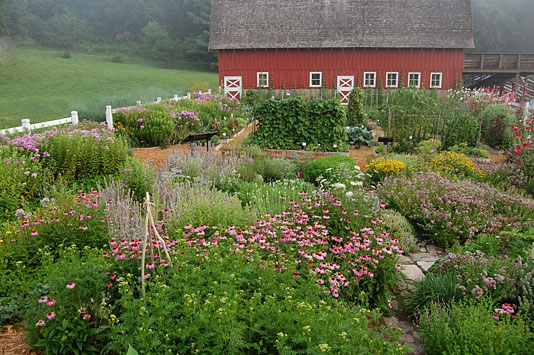
Diane Ott Whealy's garden at Heritage Farm, headquarters of the Seed Savers Exchange in Decorah, IA. All photos: Seed Savers Exchange
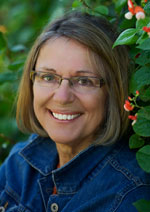
Diane Ott Whealy co-founded Seed Savers Exchange (SSE) with Kent Whealy in 1975. Today SSE is regarded as the nations leading nonprofit seed-saving organization. SSE has more than 13,000 members, made up of gardeners, orchardists, chefs and plant collectors — all dedicated to the preservation and distribution of heirloom varieties of vegetables, fruits, grains, flowers and herbs.
Regarded by many as the "Mother of the Heirloom Seed Movement," Diane has been a national leader and strong advocate for the protection of the earth’s rare genetic food stocks for over 37 years. Her recently-released memoir is Gathering: Memoir of a Seed Saver.
In 1986 Diane helped develop Heritage Farm, SSE’s scenic 890-acre headquarters near Decorah, IA. Heritage Farm is an educational center designed to maintain and display collections of endangered food crops. She also founded the Flower and Herb Exchange, where members offer more than 2,000 heirloom flowers and herbs for exchange each year.
By Diane Ott Whealy
At the start of a year, many gardeners open their seed catalogs to see what’s new. This year, try a different approach: Take a look at what’s old.
Often called "heirloom seeds," the old varieties number in the thousands, making it difficult to choose a favorite. It’s like a mother trying to single out her favorite child. And like a child, each seed has its own personality, flaws and gifts.
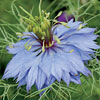
Love-in-a-mist
There are unusual seeds, such as rat-tailed radish, dragon-tongue carrot, bloody butcher corn and rattlesnake bean. And then there are sentimental varieties, such as Aunt Molly’s ground cherry or Aunt Ruby’s German green tomato. Heirloom flowers, such as love-in-a-mist and kiss-me-over-the-garden-gate, bring romance to the garden.
Thousands of heirloom varieties are preserved at Seed Savers Exchange, a pioneer in saving and collecting heirloom seed for more than 35 years. These heirloom varieties of open-pollinated seeds are grown and preserved at Heritage Farm, making the ones I've listed below just the tip of the iceberg.
My favorite heirloom seeds bring beauty, diversity and history into my garden as well as great taste. Every seed has a story: the people who grew it, where it was grown, how it was prepared for food and how the seeds were saved and passed on from generation to generation. Each seed is a living link to our ancestors. When we plant these heirloom seeds, we become part of the story and the next generation of seed savers.
Here are some of my favorites, grouped by "edibles" and flowers. All varieties are available from Seed Saver's Exchange:
An open-pollinated (OP) variety is one that breeds true from seed, meaning the seed saved from the parent plant will grow offspring with the same characteristics. OP seed is produced by allowing a natural flow of pollen between different plants of the same variety.
Heirloom varieties are OP varieties with a long history of being cultivated and saved within a family or group. They have evolved by natural or human selection over time.
A hybrid variety, on the other hand, does not breed true from seed; hybrid seed is produced by crossing two different parent varieties of the same species. Hybrids do not remain true in generations after the initial cross and cannot be saved from generation to generation unchanged.
This Year's Seed Holds Next Year's Garden: Saving seeds is one of gardening's best-kept secrets. When else in life can you get something for nothing?
My family only grew one tomato variety, and this was it. Long before I was born my great-great-grandparents were growing German Pink in Bavaria. It’s called a "potato-leaf" type because the foliage resembles the leaves on potato plants. It produces 1- to 2-pound, meaty, full-flavored fruits. Excellent for sauces and slicing, I remember my grandmother serving slices on a white platter, sprinkled with sugar.
Seed-saving: Cross-pollination between modern tomato varieties seldom occurs, except in potato leaf varieties which should be at least 50 feet from other tomato varieties. Do not save seeds from double fruits or from the first fruits of large-fruited varieties. Pick at least one ripe fruit from each of several plants. Squeeze seeds and juice into a strainer and wash, spread on a paper plate, and dry.
Saving tomato seeds is a bit different from other plants. To get details on the process, read How to Save Tomato Seeds in PDF or watch the Seed Savers video, Tomato Seed Saving.
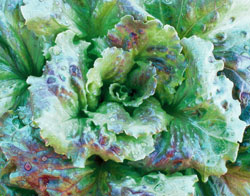
This was given to Seed Savers Exchange in 1977 by Chloe Lowry, our 90-year-old neighbor in Missouri. The seed was handed down from one of her ancestors, George Admire, a civil war veteran born in 1822. Bronze-tinged leaves form loose heads. It stays crisp and sweet — even in extremely hot temperatures. It is slow to bolt (form seeds).
Seed-saving: There is only a slight chance that lettuce will cross-pollinate. Allow a few plants to bolt and form seed. To collect the seed, shake seedheads into a paper bag every day for about two weeks. I always let the lettuce drop seed in my garden. Last spring, before I was even thinking about planting, I noticed a patch of lettuce and purple violas that had grown from last year’s seed — a salad mix without any effort on my part.
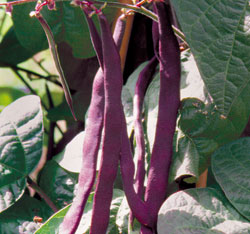
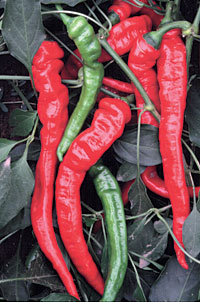
This heirloom pole bean was discovered by Henry Fields in an Ozark garden in the 1930s. Plants climb vigorously to 6 feet and are productive, flavorful and meaty. The 5-7" pods turn green when blanched in boiling water. The blossoms are also purple, making it an excellent choice for edible landscapes. I grow on a trellis, underplanted with basils, French tarragon and snapdragons. 68 days to maturity.
Seed-saving: Beans are self-pollinating and almost never cross. Save seed from healthy plants that ripen early. Harvest seedpods when completely dry. Hand shell or crush them in a cloth or burlap bag.
A family heirloom given to SSE by Jimmy Nardello, whose parents brought the seeds to the U.S. in 1888, when they emigrated from a small village in the Basilicata region of southern Italy. The bright red sweet pepper is fabulous raw or fried. It’s my favorite pepper to add flavor and color to fried potatoes. Productive plants are loaded with 10-inch-long peppers. 80-90 days from transplant.
Seed-saving: Peppers will cross-pollinate. To save pure seed, grow only one type of pepper or separate different varieties by at least 500 feet. Select fully ripe fruit, remove seeds from core and dry on a paper plate.
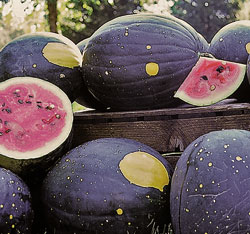
We thought this legendary melon was long-lost, but rediscovered by Seed Savers Exchange at the Merle Van Doren farm in Macon, MO. The dark green oval melons are covered with pea-sized bright yellow "stars" and usually one larger "moon." The leaves also have the same design. The sweet pink flesh is excellent. Matures in 90-95 days and is well worth the wait.
Seed-saving: Watermelons will cross-pollinate, so you need to separate varieties by a quarter-mile or hand-pollinate. Always select disease-free, early maturing melons to save for seed. Remove seeds from ripe melons, thoroughly wash in a strainer, and dry.
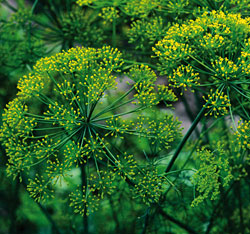
This is another staple, grown on my grandmother’s Iowa farm since 1920. I grew up on the farm and remember the dill. I would take large bunches to the Winneshiek County fair each summer and always won blue ribbons. The fragrant heads are large with plump seeds, perfect for dill pickles, summer salads or fabulous filler for summer flower bouquets.
Seed-saving: Dill will cross pollinate, so you should grow only one type (or isolate by a quarter mile). Dill heads ripen unevenly and shatter easily. Individual umbels (flower heads) are harvested as they mature. Rub the umbels gently to free the seed. Any small stem pieces or other debris can be winnowed or screened.
I love self-seeding annual flowers because they are not bred "to order" as the newer varieties are. They are not created to fit into pots or grow to a certain height. None of their fragrance is lost — as sometimes happens with hybrids.
Like most flowers, old-fashioned annuals add beauty to any garden, but they also add fragrance and pollen- and nectar-rich flowers that are sure to attract pollinators and beneficial insects. Best of all, they take care of themselves by self-seeding each spring at the right time, in the right place without any guidance or design from me.
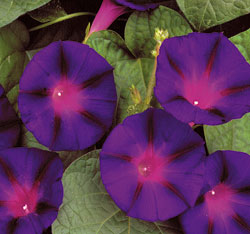
This is one of the original Bavarian varieties that started Seed Savers Exchange. The seed was given to me by my grandfather, Baptist John Ott, who got the seeds from his father, who had immigrated to St. Lucas, IA, in the early 1900s. Grandpa grew these flowers on the porch of his house every year. As a child I remember spending afternoons sitting on that porch surrounded by the morning glories trained on twine strings to completely cover the sides. These vines have a permanent home on the south side of Heritage Farm’s barn, where they grow to more than 15 feet, covered with delicate velvet-petaled flowers.
Seed-saving: Morning glories will cross-pollinate. Gardeners should only grow one variety at a time to save pure seed, or isolate varieties by a quarter mile. In late summer and fall, I’d help Grandpa pluck dry seedpods off the vine. The pods will become dry and brittle and look like golden buttons. We would hurry to pick the pods before they burst, shedding the black seeds on the ground, which was alright with him. Still, we always wanted some seeds to share.
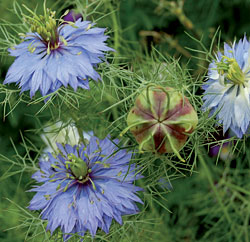
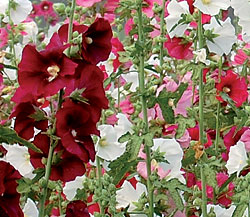
First appeared in England around 1570. Some imaginative folk names include love-entangle and Jack-in-prison. I grow them because every part of this plant is decorative: the leaves, blossoms and the striped seedpods. It is hard to resist popping the seedpods when they are green because they burst like little balloons.
Seed-saving: Extremely easy for seed savers. When the blooms fade, a very ornamental seedpod is formed. Once the seedpod turns brown, cut them off. Allow the pod to dry before cracking it open and removing the small seeds. Store the seeds in a cool, dry area for planting in spring.
Having graced the outbuildings of farms since the early 1900s, this has become a classic in my garden. With its 9-foot spires, it could easily conceal an outhouse — and eliminate the need for a visiting lady to ask where it could be found. The Outhouse hollyhock is a biennial, so seeds will form small plants the first year and bloom the second. Once established, the plant reseeds freely, so you’re likely to have plants in bloom every year. Single blooms are white, magenta, pink and dark burgundy. Although there is no outhouse at Heritage Farm, hollyhocks are still grown for their simple beauty, the hummingbirds, and to make hollyhock dolls.
Seed-saving: Harvest seedheads once they have turned brown. Wear gloves and long sleeves because hollyhock plants and seeds slough off tiny hairs that can irritate the skin. Gently rub the seedheads between your hands and winnow off the chaff.
Copyright © www.100flowers.win Botanic Garden All Rights Reserved